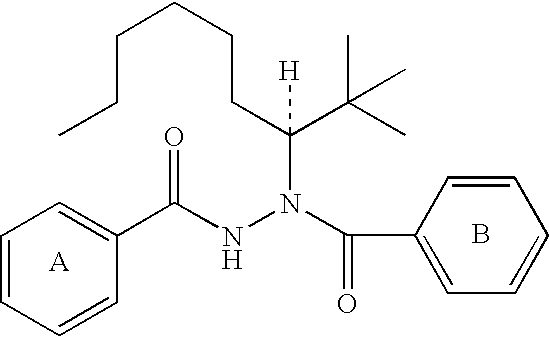Diacylhydrazine ligands for modulating the expression of exogenous genes in mammalian systems via an ecdysone receptor complex
a technology of ecdysone receptor and diacylhydrazine, which is applied in the field of gene expression and non-steroidal ligands, can solve the problems of system limitation, system leakage, and limited use of pr1-a
- Summary
- Abstract
- Description
- Claims
- Application Information
AI Technical Summary
Problems solved by technology
Method used
Image
Examples
example 1
Preparation of Compounds
[0290] The compounds of the present invention may be made according to the following synthesis routes.
1.1 Preparation of RG-115853
[0291] 20.0 g (0.232 mol) of pivaldehyde were dissolved in 600 mL THF in a 3-neck round bottom 2 L flask equipped with a magnetic stir bar and thermometer. The flask was flushed with N2. The solution was cooled to 65° C. in a dry ice / acetone bath. 100 mL of a 2.3 M solution of hexyllithium in hexane (0.23 moles) was added by means of a 20 mL glass syringe inserted between a rubber stopper and the glass neck, in small 5 mL portions, keeping the temperature at or below −60° C. After stirring at −60° C. for 1 hour, the reaction was allowed to warm to ca. −5° C. over one hour. The reaction was cooled again to −60° C., and slowly quenched with aqueous NH4Cl solution, and allowing the temperature to rise above −50° C. The reaction mixture was allowed to warm up as 100 mL of water were added. The THF was removed on a rotary evaporator...
example 2
Biological Testing of Compounds
[0354] The ligands of the present invention are useful in various applications including gene therapy, expression of proteins of interest in host cells, production of transgenic organisms, and cell-based assays.
27-63 Assay
[0355] GAL4 DBD (1-147)-C / EcR(DEF) / VP16AD-βRXREF-LmUSPEF: The wild-type D, E, and F domains from spruce budworm Choristoneura fumiferana EcR (“CfEcR-DEF”; SEQ ID NO: 1) were fused to a GAL4 DNA binding domain (“Gal4 DBD1-147”; SEQ ID NO: 2) and placed under the control of a phosphoglycerate kinase promoter (“PGK”; SEQ ID NO: 3). Helices 1 through 8 of the EF domains from Homo sapiens RXRβ (“HsRXRβ-EF”; nucleotides 1-465 of SEQ ID NO: 4) and helices 9 through 12 of the EF domains of Locusta migratoria Ultraspiracle Protein (“LmUSP-EF”; nucleotides 403-630 of SEQ ID NO: 5) were fused to the transactivation domain from VP16 (“VP16AD”; SEQ ID NO: 6) and placed under the control of an elongation factor-lax pro...
PUM
 Login to View More
Login to View More Abstract
Description
Claims
Application Information
 Login to View More
Login to View More - R&D
- Intellectual Property
- Life Sciences
- Materials
- Tech Scout
- Unparalleled Data Quality
- Higher Quality Content
- 60% Fewer Hallucinations
Browse by: Latest US Patents, China's latest patents, Technical Efficacy Thesaurus, Application Domain, Technology Topic, Popular Technical Reports.
© 2025 PatSnap. All rights reserved.Legal|Privacy policy|Modern Slavery Act Transparency Statement|Sitemap|About US| Contact US: help@patsnap.com



